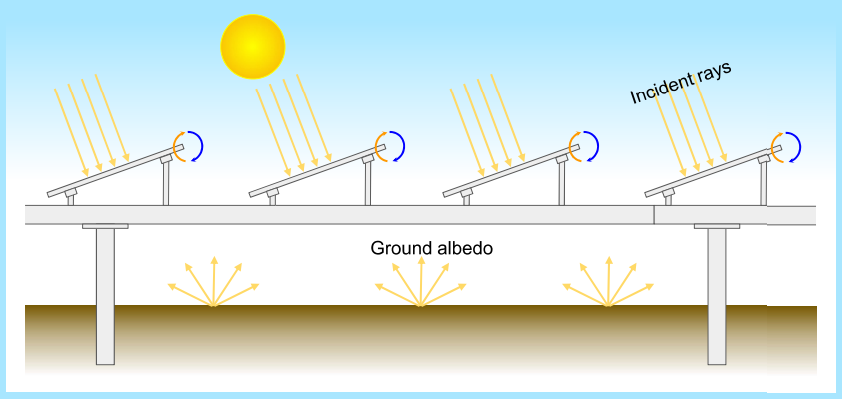
Highest Energy Gain & Capacity Utilization Factor (CUF)
Lower levelized cost of energy (LCOE) vs other solar energy products
H I G H E S T |
Energy Gain in the Market | 38% |
| Capacity Utilization Factor (CUF) | 24% | |
| Generation (MU/MWp/Year) | 2.1 | |
| Generation (kWh/kWp/Day) | 5.8 |
 |
Versus: | With Monofacial Panels | With Bifacial Panels |
| poly modules, static fixed tilt | 26% | Year1 : 38%, Lifetime : 41% | |
| same modules, HSAT** Tracker | 7% | Year : 11% , lifetime 13% | |
| *All the parameters depend upon the location, irradiation, ground albedo & module type **Conventional Horizontal Single Axis Tracker |
|||
| Tonnage 170 kmph stowage wind speed |
Upto 40 Tons/MW even with tilted panels, matches HSAT (Horizontal Single Axis Tracker) *Depends on panel type, wattage, site, wind loads |
||
Unique patented structural design & drive mechanism, featuring:
|
|||
 |
 |
 |
 |
| Optimal Latitude based tilts (10° to 35°) | Equatorial axis tracking results in higher energy output | No Lubrication | Designed for high wind speeds |
Performance Advantages :
Structural Advantages : |
 |
| SunCaptor® ITSAT | Panel stays ~4 °C cooler than Static Structure |
|---|---|
Daily higher output |
|
~17% more lifetime generation |
|
| HSAT Tracker | Panel runs hotter by ~3 °C compared to fixed static structure |
| Tracking Type | Individually Tilted Single Axis Tracker |
| Tracking Range | -45° to +45° Hour Angle extendable, if required |
| Axis Tilt Angle | 10° to 35° |
| Tracking Algorithm | Astronomical data-based with Backtracking |
| Tracking Accuracy | 1 degree |
| Stowing Time | Less than a minute |
| Power Supply | Self-Powered with grid and/or battery backup |
| Tracker Driving System | Belt & Steel Cable |
| Motor Type | BLDC |
| Communication | RS-485/MODBUS/Ethernet |
| Night-time Stowage | Yes |
| Sensors included | Inclinometer and anemometer |
| Over rotation protection | Soft limits and mechanical hard stop |
| Principal Materials | Hot dip Galvanized MS / Galvalume and SS |
| Wind Resistance | 170 kmph at stowage (3 sec gust 215 kmph) 50 kmph during tracking Customizable for other wind speeds |
| Installation method | Rapid assembly enabled by fully bolted joints |
| Snow load | Tilted panels naturally shed snow at all positions |
| Environmental protection (IP ratings) | IP65 casing for Controller, Motor & Power Unit |
| Module Configuration | Portrait (1P) |
| Module Compatibility | All PV modules (Monofacial/ Bifacial) large format. Gives great results with Bifacial |
| Module Attachment | Clamping / Bolting |
| Row Accommodation | 20-30 modules in a row |
| Block Capacity | 80-200 Panels |
| Typical Height at stowage | Lower edge: 1.2m; Upper edge: 1.5m |
| Slope North-South | +5° |
| Slope East-West | ± 5° |
| Ground Clearance | Minimum 500 mm at 45°-hour angle |
| Supported Foundation Types | Standard Pile / Bored cast in situ/ Driven Pile / Rammed |
| Tracker Maintenance | Normal service life of Tracker parts is 25 years |
| Comprehensive plant monitoring and maintenance | Includes software updates, manual/automatic cleaning online monitoring, wind event response |
| Bushing Maintenance | No cleaning or lubrication for lifetime of plant No roller bearings. |
| Structure | 10 Years (extendable) |
| Motor | 05 Years (extendable) |
| Electronics | 05 Years (extendable) |
| Useful Design Life | >25 Years for all components |
| Land Required | Approx. 3.2 to 3.6 acres per MWP (Dependent on Panel Wp & Site location) |
| Ground Coverage Ratio | Typical range: 35-45% |
| Number of Foundations | 350 to 450 (Dependent on Panel Wp, Soil depth) |
Note: Specification are subject to change based on the project scale and site location.